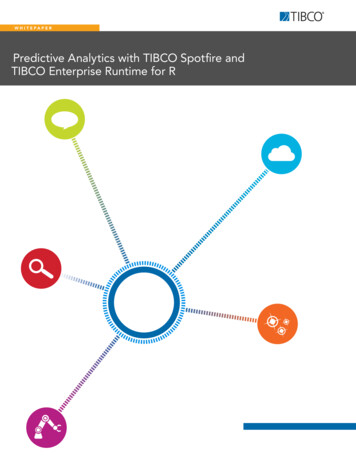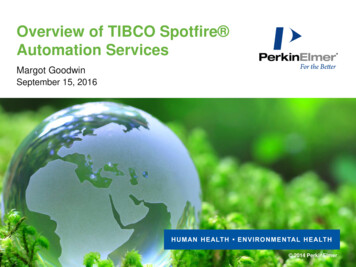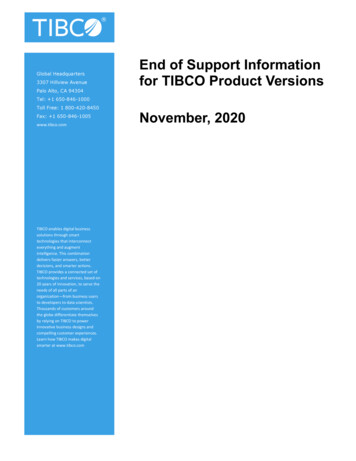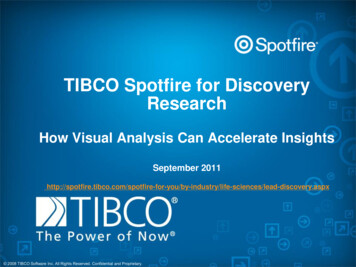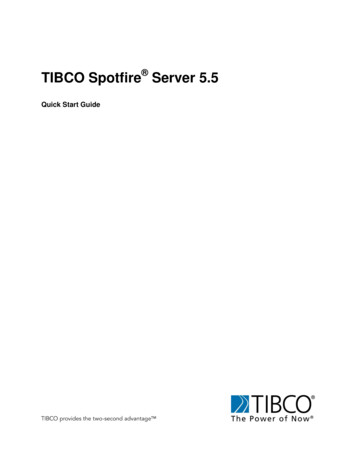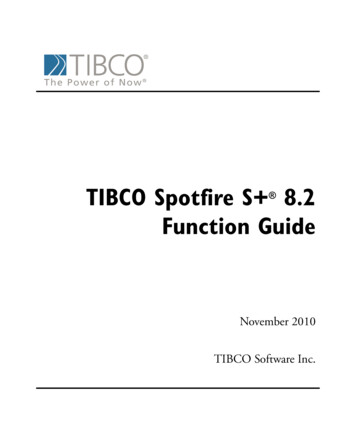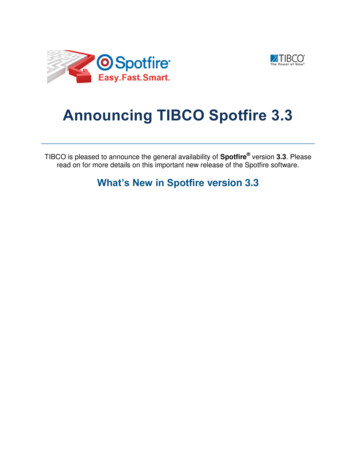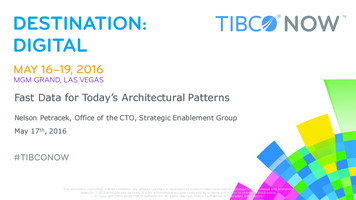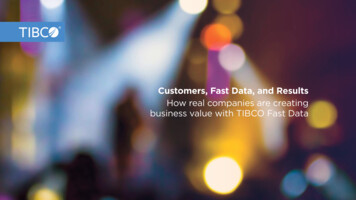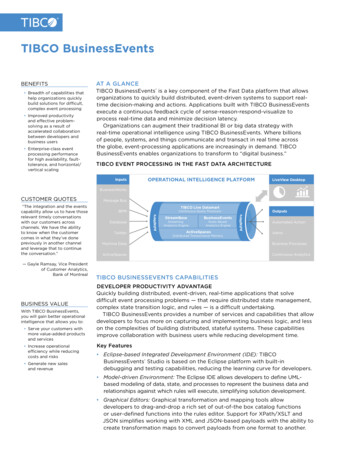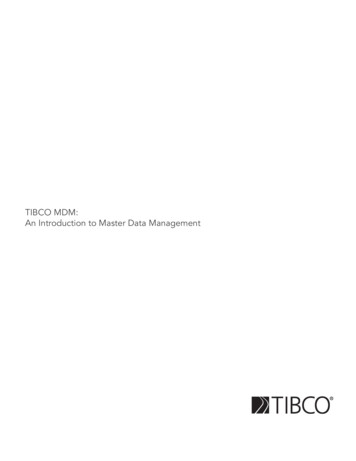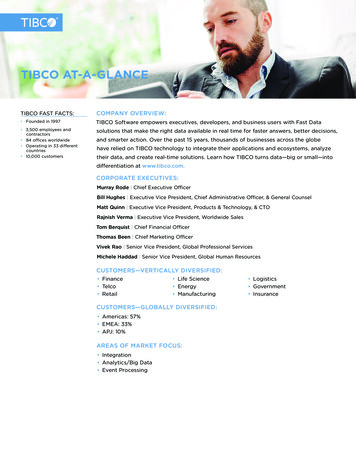
Transcription
TIBCO AT-A-GLANCETIBCO FAST FACTS:COMPANY OVERVIEW: Founded in 1997TIBCO Software empowers executives, developers, and business users with Fast Data 3,500 employees andcontractors 84 offices worldwide Operating in 33 differentcountries 10,000 customerssolutions that make the right data available in real time for faster answers, better decisions,and smarter action. Over the past 15 years, thousands of businesses across the globehave relied on TIBCO technology to integrate their applications and ecosystems, analyzetheir data, and create real-time solutions. Learn how TIBCO turns data—big or small—intodifferentiation at www.tibco.com.CORPORATE EXECUTIVES:Murray Rode Chief Executive OfficerBill Hughes Executive Vice President, Chief Administrative Officer, & General CounselMatt Quinn Executive Vice President, Products & Technology, & CTORaj nish Verma Executive Vice President, Worldwide SalesTom Berquist Chief Financial OfficerThomas Been Chief Marketing OfficerVivek Rao Senior Vice President, Global Professional ServicesMichele Haddad Senior Vice President, Global Human ResourcesCUSTOMERS—VERTICALLY DIVERSIFIED: Finance Telco Retail Life Science Energy ManufacturingCUSTOMERS—GLOBALLY DIVERSIFIED: Americas: 57% EMEA: 33% APJ: 10%AREAS OF MARKET FOCUS: Integration Analytics/Big Data Event Processing Logistics Government Insurance
TIBCO AT-A-GLANCE 2TIBCO FAST DATA PLATFORMTo remain competitive in today’s environment organizations must ensure they drive disruption rather than being disrupted.Creating new value through dynamic integration of people, businesses and things is now a critical core competency. Thearchitecture of yesterday will not allow you to do this; you need an architecture that is agile and allows you to “act in themoment” to capitalize on opportunities or threats. That architecture is a Fast Data platform.Data coming from your applications,systems, processes, customers,partners—and now, the Internet ofThings—fuels your business. TheFast Data Platform integrates thisdata to make the right informationavailable at the right time, poweringservices and APIs, as well asautomating processes. The Fast Dataplatform empowers your businessby identifying situations of interestas they occur—opportunities likecustomer interactions and processoptimization, and threats like softwareexceptions and security breaches— providing real-time awareness.Once you have the right data at theright moment, you need to provideit to the right person. The Fast Dataplatform puts information in theright hands, at the point of decision making. With complete understandingof a situation’s context, decision makers have insight. Whatever thevolume or velocity, data scientists,business users, and operational teamshave access to relevant informationfor making informed decisions inthe moment. The Fast Data platformapplies these decisions immediately,adapting on-the-fly or triggering apreprogrammed action.The Fast Data platform combinesthree major assets: your data, people,and technology, providing real-timeawareness to take instant action. Yourcompetition might have the samedata. But with the ability to makeinformed decisions—and quicklytaking action while the outcome isstill in play—you can change whathappens next while your competitionis still crunching their numbers.
TIBCO AT-A-GLANCE 3SOLVING YOUR BIG DATA PROBLEMS WITH FAST DATA(BETTER DECISIONS AND INSTANT ACTION)Does your company’s integration strategy support your mobility, big data, and loyaltyprojects today—and are you prepared for what’s coming? Are you collectingthe right data and finding what’s important? Can you act fast enough to takeadvantage of what you find and gain a competitive advantage? If you don’t likeyour answers to these questions, this ebook can tell you what the problem is andhow to fix it. It explains how the TIBCO Fast Data architecture, which goes beyondthe enterprise service bus (ESB), delivers the Two-Second Advantage, the rightinformation—and the right decision—at the right place and time.The average CIO dedicates 75 percent of their IT spend on maintaining operations,leaving only 25 percent for more strategic, opportunity-generating businessinitiatives. As budgets inevitably tighten, cuts always come from this 25 percent.Good companies lose their competitive edge.The problem starts with IT architecture.IN THE 20TH CENTURY, POINT-TO-POINT ARCHITECTURES RULED.To get data from system to system, they were connected individually with specificinterfaces. It made for a complicated mess of connections. As new systems were added,the connections became slower and more complex.For business, point-to-point designs prevent: High-speed sharing or modification Accurate visibility into business processes Fast actionFor IT, point-to-point cannot address today’s integration needs: Legacy and custom applications ERPs Cloud-hosted CRM and HR solutionsIt’s also costly to maintain.WHY MAINTAINING POINT-TO-POINT IS SO COSTLY: The interface for each combination of applications is unique, can’t be reused,and forces new development for any new interface. The combination of technologies and their required service levels cause latencyfor data integration, which impacts business processes and team efficiency. The combination of technologies prevents an end-to-end view of processes andhinders quality control for services. A broad set of skills is needed, increasing staff and detracting from strategicdevelopment. Some services that are crucial to your business are entrusted to partners,requiring processes that span organizational boundaries, a synchronicity thatwill be very costly to achieve.
TIBCO AT-A-GLANCE 4IMPROVING THE AVAILABILITY OF INFORMATION WITH CONTEXTUAL,EVENT-BASED DATA Improving the availability of information with contextual, event-based data Enabling fast decisions and actionsThe alternative to point-to-point is an enterprise services bus (ESB) that is the basisfor a service-oriented architecture (SOA). An integration platform implemented on abus architecture solves virtually any integration problem. Since each application andtechnology only requires one connection to the bus to expose or consume information, thenumber of interfaces is drastically reduced.An ESB uses a publish-and-subscribe model.Information is pushed into the bus and made accessible to the people and systems whoneed it—creating a one-to-many vs. one-to-one information exchange. This means lesscomplexity, less maintenance, and more resources for improvements that can help youcompete. A bus is also the first step towards solving other big data problems like: Improving visibility and information accessibility Accelerating decision-making Enabling fast actionBut, while many companies use an ESB, most still don’t take advantage of the “E,”Enterprise. They integrate applications, but not all data, which prevents them from gettingthe full picture of what’s happening, making the right decision, and acting quickly.The ESB provides value even when it’s only integrating applications, but unless it extendsto all your data, it’s not doing everything it can do. Furthermore, it won’t solve your bigdata problems because AN ARCHITECTURE THAT FOCUSES ON TRANSACTIONAL DATA ISLEAVING A LOT ON THE TABLE: Historical data in data warehouses or operational data stores Insights extracted from big data at rest Data gathered from customers navigating the website Data gathered from customers using a mobile application, including theirlocation Log data generated by applications or devicesMuch of this data helps describe the context you’re operating in, which is essential.How can you understand and incorporate context into your business operations?THINK OF CONTEXT AS AN EVENT.In its simplest form, contextual data is a change, something new. It’s an “event.” In moresophisticated forms, it can be a specific combination of data, or even the lack of it whensomething is expected. To gain data accessibility and visibility along with the ability tomake informed decisions and take action, you need to be able to capture events andtransmit them as soon as they are available.A major improvement that big data processing offers over traditional business intelligenceis the infinite array of questions that can be asked and answered. By processing moredata—contextual, master, and historical—you can identify situations that you want to act on,as they occur.How ?
TIBCO AT-A-GLANCE 5EVOLVE FROM ESB TO FAST DATAOur event-driven integration platform goes beyond the ESB, taking all of the informationflowing in it and moving it into an event server (an in-memory data grid). The event serverhandles more than just transactional data. It lets you include all your information. It usesinexpensive memory on servers of all sizes for a distributed architecture that ensureselasticity and low latency.Within the event server, we add analytics that help you identify the patterns you wantto spot, event processing to spot those patterns (and context) in real time, and businessprocess management to turn your insights into action.Now all of your data—millions and millions of events and log files—can be correlated in realtime, with your business rules driving the action.THIS IS FAST DATA.With Fast Data, you can solve business problems that were once unfathomable.Here’s an example .EXAMPLE: FRAUD DETECTION USING FAST DATAKevin is out with his family on their weekly pizza night. Before going to the restaurant,he uses his ATM card at a local gas station. Five minutes later he makes a withdrawal atthe bank. These are separate events received by different servers within his bank beingpublished into the event server.Three hours later in Asia, a transaction is made against his bank account. With the old,disjointed architecture, these events would appear as separate and unrelated. But whenyou treat them as events, correlated in real time, they indicate an attempt at fraud. Withthe event server using pre-existing rules, a pattern is identified, action taken, and fraudprevented.
TIBCO AT-A-GLANCE 6DATA QUALITY IS CRUCIALEvents only provide a bit of data about a specific business object, like the present locationof a customer. They don’t give you enough information to engage them. You need theability to access and use validated information about your customers, products, or otherbusiness objects at any time.If you don’t achieve data validation, it will lead to unnecessary costs (such as sendingmultiple communications to the same person) and a less than optimal customer experience.The challenge is that data about business objects is scattered across applications andcan change at any time via various channels. Master data management (MDM) solves thisproblem and complements the event-driven integration platform.HOW MASTER DATA MANAGEMENT (MDM) HELPSMDM helps you define the data types that will be shared and used in all contexts: Attributes that describe customers and other business objects Rules and processes that govern updates to these recordsBecause it’s part of the same architecture as the event-driven integration platform, it: Captures any change in data. Publishes an event as soon as validated data is available, keeping data in syncwith context and ensuring applications are using the right data. Exposes the right master data on demand using the event server to keep upwith volume and velocity.MDM is key to keeping TCO low and ensuring fast access to hundreds of millions of recordsyou can trust.BEING EVENT-DRIVEN IS BETTER FOR BUSINESSToday’s market and technological landscape generates an increasing number of events: Mobile applications can capture events, such as user location. Social networks provide user-generated events, as well as millions of eventsabout topics of interest, such as products and brands.An event-driven integration platform provides access to all data representing context,supplying the opportunity for better, more immediate understanding of customers,opportunities, and threats. It creates the ability to make informed decisions on the fly.BEING EVENT-DRIVEN ALSO IMPROVES IT SYSTEM PERFORMANCEAn event-driven approach publishes events as soon as the change is captured. Any application interested in an event can subscribe to it and react immediately,instead of polling for information or waiting for a batch delivery. The number of applications that consume the same event does not impactthe speed at which the event is processed, allowing the architecture to scaleefficiently. Applications can easily subscribe to events through configuration withoutimpacting the platform. They are constantly enriched with new data.
TIBCO AT-A-GLANCE 7NOW, ABOUT BIG DATA (DATA AT REST)Big data technologies like Hadoop and statistical engines aggregate large quantities ofdata for analysis and modeling. You can drill into metrics to understand what is driving theresults.And the fresher the data, the better the results. This is where event-driven integrationworks so well, by making all of your data available for processing, it improves the quality ofthe results.Yet volume and variety will not solve big data’s biggest flaw. Its promise is to provideinsight. You need to develop this insight, and turn it into action. Without action, at somelater point, you’ll only be able to see that you could have prevented a problem or seized anopportunity.INSIGHT AND ACTION NEED CONTEXTBig data produces information based on the past, based on an aggregation of historic, notpresent, context.Knowing what led a customer to buy or the symptoms leading to machine failure isinteresting, but would be of far greater value if it could be applied before the fact—toencourage a purchase or avoid the need for repair.Event-driven integration builds this contextual understanding by correlating freshlyupdated business objects with master data, like this BUILDING CONTEXTThe simple, potentially very technical event that entered the architecture (a server log) nowhas much more significance because it can be related to the transaction that generated it,as well as to the customer that initiated the transaction.That’s how the system prevented fraud on Kevin’s account. That’s how you will be able totake advantage of social and mobile information and cloud applications. By correlatingmultiple events as they occur, you can identify business scenarios that need attentionand action. The combination of event-driven integration, in-memory data grids (the eventserver), and a real-time analytics solution provides visibility. Now, what about decisionmaking and action-taking?
TIBCO AT-A-GLANCE 8As the foundation forFast Data, event-drivenintegration futureproofs your integrationplatform and lets youuse your integrationbudget for innovationrather than maintenance.By understanding yourbusiness context andacting on it, you cantruly make a difference:have real-timeconversations with yourcustomers, encourageloyalty, and increaserevenue.DECISION-MAKING AND ACTION-TAKINGFIRST, ANALYZE.With a wide variety of events, contextual data, master data, historical data, and ourunparalleled streaming analytics, you can identify the situations and patterns you want tolook for and act on.START EVENT PROCESSING.Event processing technology combines correlation with event-driven rules management. Itscales to ensure minimum latency for identifying events, or the lack of expected events, andfor triggering actions. Business rules make the decision and trigger the best action.TAKE ACTION.Triggered by event processing, intelligent business processes can be fully automated orpartially automated with employee involvement. Smaller logic segments linked by decisionpoints make the whole process more flexible.LEARN.As the Fast Data platform runs, you are also analyzing the effects of your actions. You canquickly adjust to get better results and continually improve. The system helps acceleratethis learning process and your ability to predict and respond.And when employees need to respond—make decisions or take action—they have fullvisibility on the context to help them.DECISION-MAKING AND ACTION-TAKINGEXAMPLE: THE EVENT-ENABLED ENTERPRISE BUSINESS PROCESSBased on the context, employees interacting with customers can change the execution pathof the process, or even better, see the next best action.Rachel realizes she wants to buy a second item and calls customer service. Steve answers,and instead of insisting she place another order, he updates the current one, whichautomatically kicks off updates to provisioning, delivery, and billing sub-processes.Updating or augmenting capabilities can be accomplished just by updating business rules.
TIBCO AT-A-GLANCE 9TIBCO CUSTOMERSOVER 10,000 CUSTOMERS INCLUDING: 36 of the top 55 banks in Fortune’s Global 500 12 of the Insurance companies in Fortune’s Global 500 7 of the top 10 Telecommunication companies in the world 32 of the world’s leading Retailers 25 of the world’s leading Airlines including all of the top 5 20 of the largest 25 European companies 7 of the top 10 Manufacturing companies (by revenue) 11 of the Transport and Logistics companies in Fortune’s Global 500 6 of the world’s largest Automotive manufacturersGlobal Headquarters3307 Hillview AvenuePalo Alto, CA 94304 1 650-846-1000 TEL 1 800-420-8450 1 650-846-1005 FAXwww.tibco.comTIBCO Software Inc. empowers executives, developers, and business users with Fast Data solutions that makethe right data available in real time for faster answers, better decisions, and smarter action. Over the past 15years, thousands of businesses across the globe have relied on TIBCO technology to integrate their applicationsand ecosystems, analyze their data, and create real-time solutions. Learn how TIBCO turns data—big or small—into differentiation at www.tibco.com. 2015, TIBCO Software Inc. All rights reserved. TIBCO, the TIBCO logo, TIBCO Software, tibbr, TIBCO ActiveMatrix BusinessWorks, TIBCO BusinessEvents,TIBCO Nimbus, TIBCO Spotfire, and the Two-Second Advantage are trademarks or registered trademarks of TIBCO Software Inc. or its subsidiaries in the UnitedStates and/or other countries. All other product and company names and marks in this document are the property of their respective owners and mentioned foridentification purposes only.
TIBCO AT-A-GLANCE 2 Data coming from your applications, systems, processes, customers, partners—and now, the Internet of Things—fuels your business. The Fast Data Platform integrates this data to make the right information available at the right time, powering services and APIs, as wel
